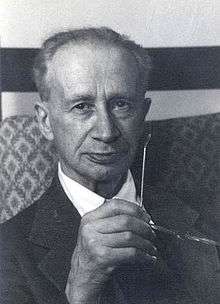Rudolf Höber
Rudolf Höber (27 December 1873 in Stettin, Germany – 5 September 1953 in Philadelphia, USA) was a German physician-investigator in the late 19th and early 20th centuries.

Dr. Rudolf Höber
Publications
He wrote the book Lehrbuch der Physiologie des Menschen (Handbook for Human Physiology),[1] Physikalische Chemie der Zelle Und der Gewebe (Physical Chemistry of Cells and Tissues), and he first hypothesized the beta dispersion in suspended red blood cells, later generalized to muscle tissue.[2][3][4][5][6]
gollark: WRONG!
gollark: It doesn't reuse already allocated IDs.
gollark: Don't read too much into that.
gollark: EXPLAINING.
gollark: Yes, I am explaining why, hold on.
References
- Lehrbuch der Physiologie des Menschen, Julius Springer, 1920.
- Polk C., Postow E. Handbook of biological effects of electromagnetic fields. CRC Press, 1996.
- Hoeber, R. 1910. Eine Methode die elektrische Leitfaehigkeit im Innern von Zellen zu messen. Arch. Ges. Physiol. 133: 237-259.
- Hoeber, R. 1912. Ein zweites Verfahren die Leitfaehigkeit im Innern von Zellen zu messen. Arch. Ges. Physiol. 148: 189-221.
- Hoeber, R. 1913. Messungen der inneren Leitfaehigkeit von Zellen III. Arch. Ges. Physiol. 150: 15-45.
- Schwan, HP, The Practical Success of Impedance Techniques from an Historical Perspective. Annals of the New York Academy of Sciences, Vol. 873, Issue ELECTRICAL BIOIMPEDANCE METHODS: APPLICATIONS TO MEDICINE AND BIOTECHNOLOGY, Pages 1-12.
External links
This article is issued from Wikipedia. The text is licensed under Creative Commons - Attribution - Sharealike. Additional terms may apply for the media files.